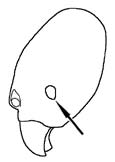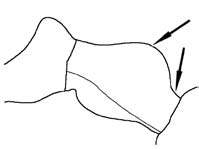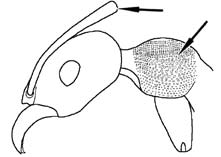Key to Pheidole of the southwestern Australian Botanical Province
This worker key is based on: Heterick, B. E. 2009. A guide to the ants of South-western Australia. Records of the Western Australian Museum, Supplement 76: 1-206. Part 2.
There is a key to Majors and Minors.
You may also be interested in
Major workers
(n.b. The major worker for Pheidole JDM 871 is not known.)
1
- Viewed in profile, junction of postpetiole with gaster narrow (Figure 648) . . . . . Pheidole megacephala
- Viewed in profile, junction of postpetiole with gaster broad (Figure 649) . . . . . 2
2
return to couplet #1
- Viewed from above, vertex of head smooth and shining (Figure 650) . . . . . 3
- Viewed from above, vertex of head reticulate (Figure 651) or striate (Figure 652) . . . . . 7
3
return to couplet #2
- Mesosoma almost devoid of sculpture, smooth and shining. . . . . Pheidole sp. JDM 874
- Mesosoma sculptured, with striae, at least, on promesonotum . . . . . 4
4
return to couplet #3
- Larger species (HW ≥ 2 mm) . . . . . 5
- Smaller species (HW < 2 mm) . . . . . 6
5
return to couplet #4
- Viewed from front, mandible quadrate, inner to outer surface (i.e. top to bottom) being about same length as angle to edge (i.e. from left to right) (Figure 653) . . . . . Pheidole hartmeyeri
- Viewed from front, mandible relatively elongate, distance from inner to outer surface being much less than distance from angle to edge (Figure 654) . . . . . Pheidole sp. JDM 558
6
return to couplet #4
- Medium-sized species (HW ≈ 1.5 mm) (mainly coastal) . . . . . Pheidole ampla
- Small species (HW ≈ 1 mm) (found in N, NW) . . . . . Pheidole sp. JDM 338
7
return to couplet #2
- Occipital lobes with strong, deep, reticulate sculpture (Figure 655) . . . . . Pheidole sp. JDM 164
- Occipital lobes striate, often weakly so (e.g. Figure 656) . . . . . 8
8
return to couplet #7
- Viewed from front, longitudinal striae on head reaching to vertex (Figure 657) . . . . . Pheidole teneriffana
- Viewed from front, longitudinal striae diverging strongly left and right near occipital lobes to become more-or-less horizontal (Figure 658) . . . . . 9
9
return to couplet #8
- Antennal scrobe long, reaching to at least midpoint of head; head elongate, about 1.5–2 times as long as wide (Figure 659) (size of major very variable, according to locality) . . . . . Pheidole sp. near variabilis Mayr (JDM 177)
- Antennal scrobe short, reaching to about midpoint of eye; head only slightly longer than wide (Figure 660) . . . . . 10
10
return to couplet #9
- Eye oblique, distinctly attenuated anteriad (Figure 661a); anterolateral and anteromedial teeth on underside of head well-developed (Figure 661b) . . . . . Pheidole bos
- Eye variable in shape but not distinctly attenuated anteriad (e.g. Figure 662a); anterolateral and anteromedial teeth on underside of head vestigial (Figure 662b) . . . . . Pheidole sp. JDM 1138
Minor workers
1mi
- Propodeum unarmed or with vestigial denticles . . . . . Pheidole sp. JDM 874
- Propodeum armed with distinct teeth or spines . . . . . 2 mi
2mi
return to couplet #1mi
- Postpetiole large and rather elongate, distinctly constricted towards its junction with gaster (Figure 663) . . . . . 3 mi
- Postpetiole small and compact (about as high as long), not constricted towards its junction with gaster (Figure 664) . . . . . 4 mi
3mi
return to couplet #2mi
- Promesonotum in profile forming a smooth curve (Figure 665) . . . . . Pheidole megacephala
- Promesonotum with protuberance in mesonotal region (Figure 666) . . . . . Pheidole teneriffana
4mi
return to couplet #2mi
- Eye markedly elongate anteriad, separated from mandibular insertion by much less than its own length (Figure 667) . . . . . Pheidole sp. JDM 164
- Eye more-or-less ovate, only slightly elongate anteriad, separated from mandibular insertion by at least its own length (Figure 668) . . . . . 5 mi
5mi
return to couplet #4mi
- Sculpture of vertex of head and dorsum of promesonotum with distinct, large reticulations, otherwise smooth and shining . . . . . Pheidole sp. JDM 558
- Sculpture of ver tex of head usually longitudinally striate, striate-shagreenate or lacking; dorsum of promesonotum lacking large reticulations . . . . . 6 mi
6mi
return to couplet #5mi
- Bright yellow species; frons of head capsule smooth and shining and longitudinal striae virtually absent past level of eye and frons not shagreenate . . . . . Pheidole sp. JDM 338
- Species usually darker with fine but distinct longitudinal striae; if light in colour then frons of head capsule shagreenate . . . . . 7 mi
7mi
return to couplet #6mi
- Colour dark chocolate; promesonotum completely shagreenate without shining patches or obvious striae . . . . . Pheidole sp. JDM 871
- Either colour lighter, or promesonotum with striae or shining patches . . . . . 8
8mi
return to couplet #7mi
- Small species (HW ≈ 0.5 mm) . . . . . Pheidole sp. near variabilis Mayr (JDM 177)
- Larger species (HW ≥ 0.8 mm) . . . . . 9 mi
9mi
return to couplet #8mi
- Mesosoma yellowish, head and gaster light brown . . . . . Pheidole ampla
- Species brown, reddish brown with darker head and gaster, or chocolate . . . . . 10 mi
10mi
return to couplet #10mi
- Scapes very long, exceeding vertex of head by about a third of their length, extensive shagreenate sculpture on mesosoma (Figure 669) . . . . . Pheidole hartmeyeri
- Scapes much shorter, barely exceeding vertex of head; shagreenate sculpture less extensive on mesosoma, especially promesonotum (Figure 670) . . . . . 11 mi
11mi
return to couplet #11mi
- Eye oblique, smaller (eye width 0.25 < length of side of head capsule) (Figure 671) . . . . . Pheidole bos
- Eye positioned along midline of head capsule, larger (eye width ≈ 1/3 length of side of head capsule) (Figure 672) . . . . . Pheidole sp. JDM 1138


























